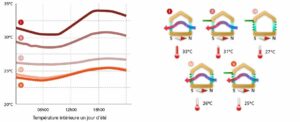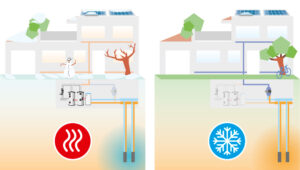Dans la journée, le thermomètre grimpe au-dessus de 30 degrés et même la nuit, il fait encore chaud : comment faire redescendre la température ambiante de quelques degrés ?
Bien souvent, on se contente d’acheter un climatiseur. La climatisation accélère le réchauffement de la planète. Elle consomme énormément d’énergie et utilisent souvent des gaz réfrigérants contribuant à l’augmentation de l’effet de serre. Voici quelques principes pour éviter les surchauffes par des mesures constructives et un comportement adéquat:
Aération nocturne et protections solaires
Pour éviter les surchauffes, le comportement des habitants est primordial. Voici les principes:
- Garder les fenêtres fermées tant qu’il fait plus chaud à l’extérieur qu’à l’intérieur
- Aérer fortement pendant la nuit, par ventilation traversantes si possible
- Baisser les stores des façades ensoleillées durant la journée

Les rideaux et stores intérieurs servent uniquement à protéger contre l’éblouissement et ne permettent pas de lutter contre le réchauffement. Equiper chaque fenêtre de protections solaires mobiles extérieures en privilégiant les protections de type stores à lamelles orientables qui permettent à la lumière naturelle de pénétrer dans la pièce.
Fermer les stores alors que le soleil ne frappe pas directement sur la vitre limite le rayonnement infra-rouge entrant dans la maison et peut limiter de 1-2 degrés la température.
Une pompe à chaleur avec refroidissement passif free-cooling
Les bâtiments équipés de pompes à chaleur avec sondes géothermiques et chauffage au sol peuvent bénéficier d’un refroidissement naturel. Le principe du refroidissement passif , free cooling, est d’utiliser le circuit de chauffage. Un échangeur de chaleur transmet la température fraîche du terrain au circuit d’eau glycolée, ce qui a pour effet de refroidir le logement.
La température ambiante peut ainsi être abaissée de 2 à 4 °C. La chaleur évacuée est stockée temporairement dans la sonde géothermique et peut servir ultérieurement à la préparation d’eau chaude sanitaire.

English version
During the day, the thermometer climbs above 30 degrees and even at night, it is still hot: how to lower the ambient temperature by a few degrees?
Quite often, we simply buy an air conditioner. Air conditioning accelerates global warming. It consumes a lot of energy and often uses refrigerant gases that contribute to the increase in the greenhouse effect. Here are some principles to avoid overheating through constructive measures and proper behaviour:
Night ventilation and sun protection
To avoid overheating, the behaviour of the inhabitants is essential. These are the principles:
Keep windows closed as long as it is warmer outside than inside
Ventilate strongly at night, by means of through ventilation if possible
Lowering blinds on sunny facades during the day.
Interior curtains and blinds are only used to protect against glare and do not prevent heating. Equip each window with external movable sunscreens, giving priority to blinds with adjustable slats that allow natural light to enter the room.
Closing the blinds when the sun does not hit the glass directly limits the infrared radiation entering the house and can limit the temperature by 1-2 degrees.
A heat pump with free-cooling passive cooling
Buildings equipped with heat pumps with geothermal probes and underfloor heating can benefit from natural cooling. The principle of passive cooling, free cooling, is to use the heating circuit. A heat exchanger transmits the cool temperature of the ground to the glycol water circuit, which cools the house.
This allows the ambient temperature to be reduced from 2 to 4 °C. The evacuated heat is temporarily stored in the geothermal probe and can later be used to prepare domestic hot water.

